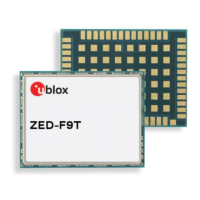ZED-F9T-Integration Manual
Configuration item Description Comments
CFG-HW-ANT_CFG_VOLTCTRL Enable active antenna voltage control
CFG-HW-ANT_CFG_SHORTDET Enable short circuit detection
CFG-HW-ANT_CFG_SHORTDET_POL Short antenna detection polarity Set to 1 if the required logic polarity is
active-low (default)
CFG-HW-ANT_CFG_OPENDET Enable open circuit detection
CFG-HW-ANT_CFG_OPENDET_POL Open antenna detection polarity Set to 1 if the required logic polarity is
active-low (default)
CFG-HW-ANT_CFG_PWRDOWN Power down antenna supply if Short
Circuit is detected
CFG-HW-ANT_CFG_PWRDOWN_POL Power down antenna logic polarity Set to 1 if the required logic polarity is
active-high (default)
CFG-HW-ANT_CFG_RECOVER Enable auto recovery in the event of a
short circuit
To use this feature, short circuit
detection should be enabled. See CFG-
HW-ANT_CFG_SHORTDET
CFG-HW-ANT_SUP_SWITCH_PIN PIO-Pin (PIO number) used for switching
antenna supply
It is recommended that you use the
default PIO and assigned pin
CFG-HW-ANT_SUP_SHORT_PIN PIO-Pin (PIO number) used for detecting
a short in the antenna supply
It is recommended that you use the
default PIO and assigned pin
CFG-HW-ANT_SUP_OPEN_PIN PIO-Pin (PIO number) used for detecting
open/not connected antenna
It is recommended that you use the
default PIO and assigned pin
Table 4: Antenna supervisor configuration
It is possible to obtain the status of the antenna supervisor through the UBX-MON-RF message.
Moreover, any changes in the status of the antenna supervisor are reported to the host interface
in the form of notice messages. See the tables below for a description of the antenna state status
and the antenna power status.
Status Description
OFF Antenna is off
ON Antenna is on
DONTKNOW Antenna power status is not known
Table 5: Antenna power status
3.1.5 Differential timing mode configuration
In differential timing mode the ZED-F9T can operate either as a master reference station or as a
slave station. Using the RTCM3 protocol, the master sends timing corrections to the slave via a
communication link enabling the slave to compute its time relative to the master with high accuracy.
This section describes how to configure the ZED-F9T high accuracy timing receiver as a master
reference station and as slave station. The section begins with a note describing the RTCM protocol
and corresponding supported message types.
3.1.5.1 RTCM corrections
RTCM is a binary data protocol for communication of GNSS correction information. The ZED-F9T
high accuracy timing receiver supports RTCM as specified by RTCM 10403.3, Differential GNSS
(Global Navigation Satellite Systems) Services – Version 3 (October 7, 2016).
The RTCM specification is currently at version 3.3 and RTCM version 2 messages are not supported
by this standard. Users can download the standard from the RTCM website here.
To modify the RTCM input/output settings, see the configuration section in the u-blox ZED-F9T
Interface Description [2].
UBX-19005590 - R01
3 Receiver functionality Page 12 of 80
Advance Information

